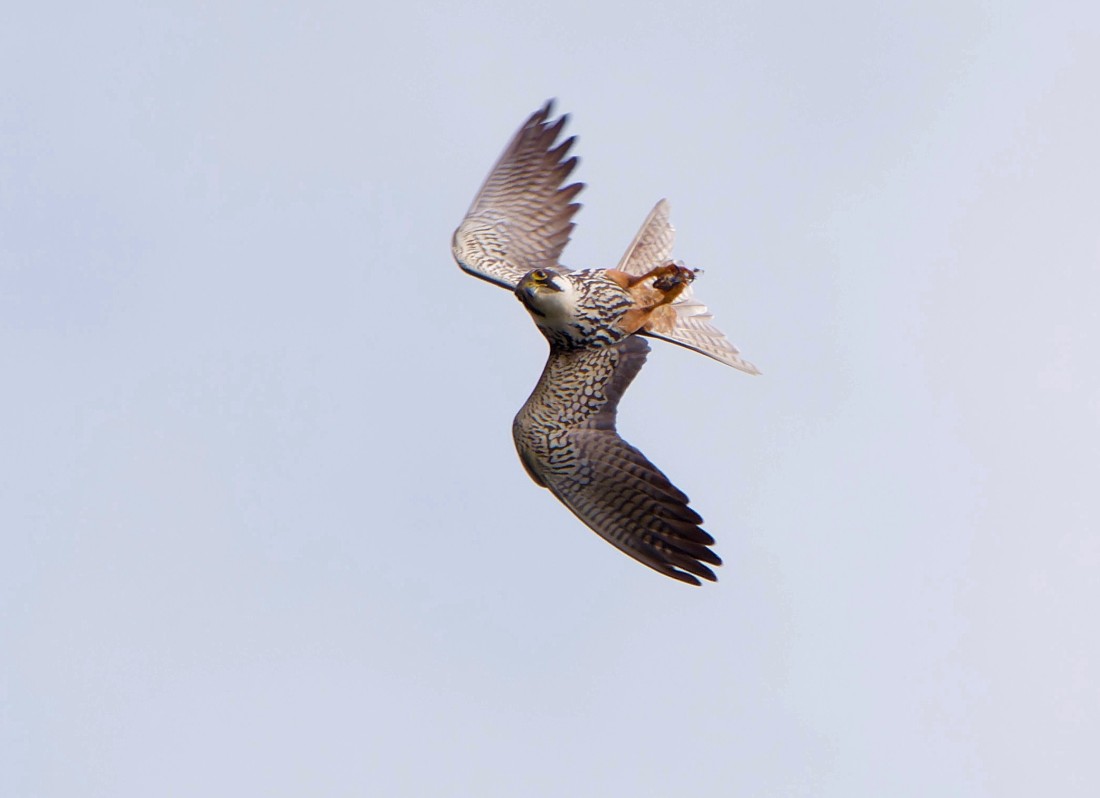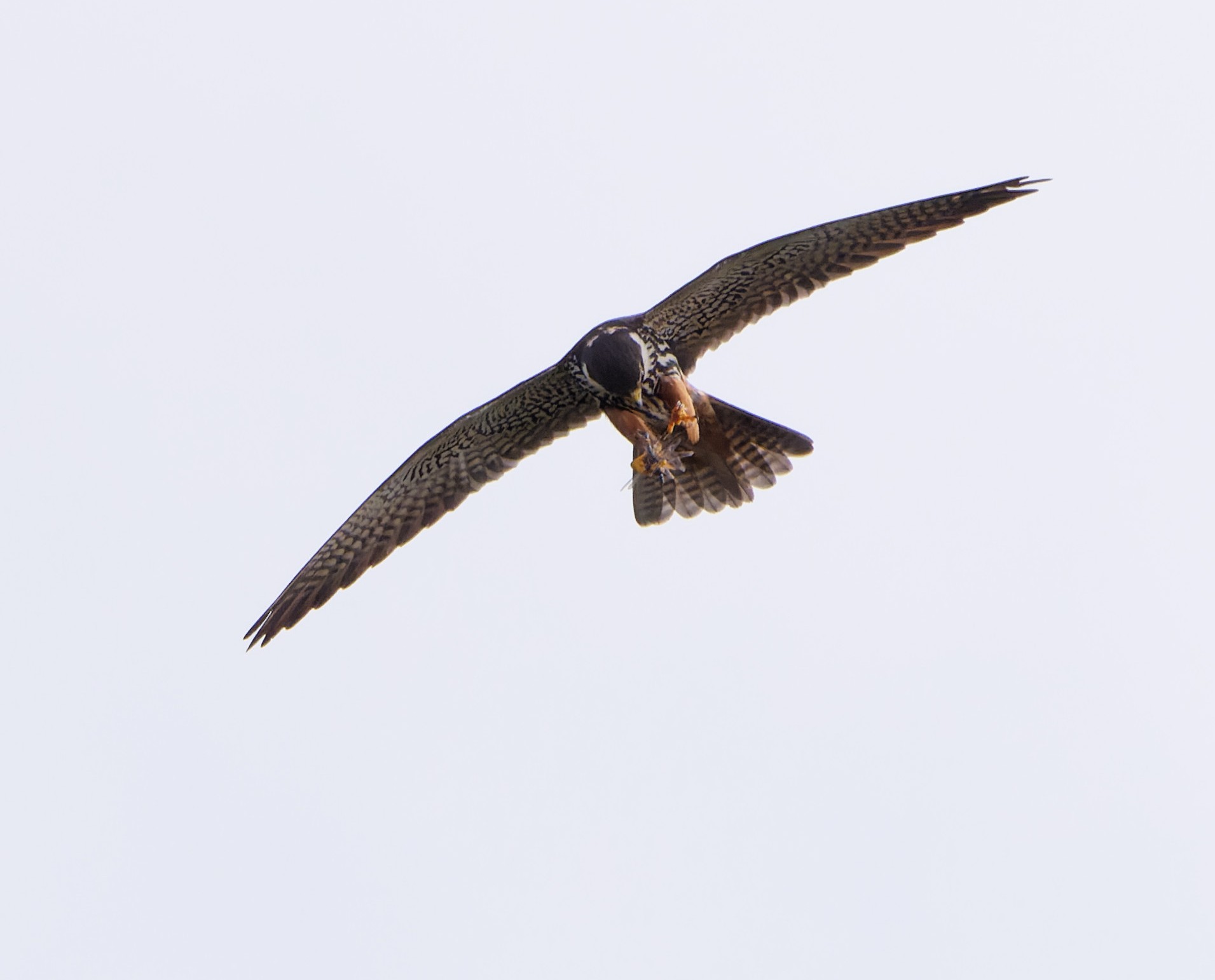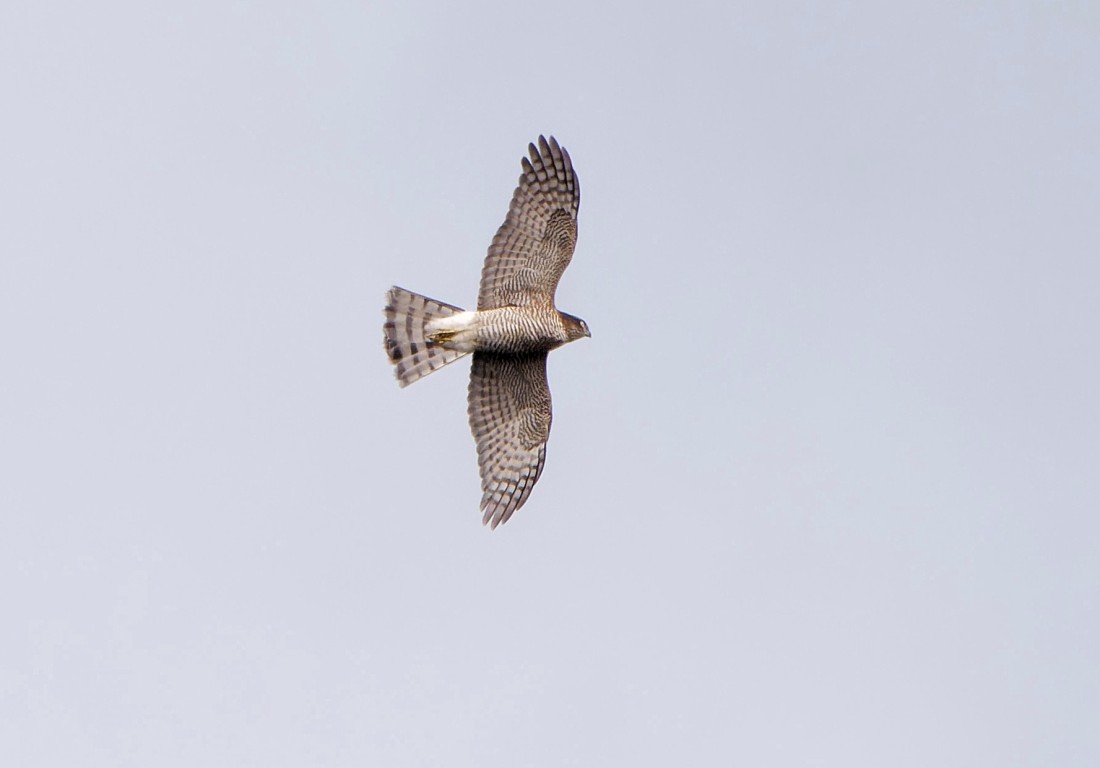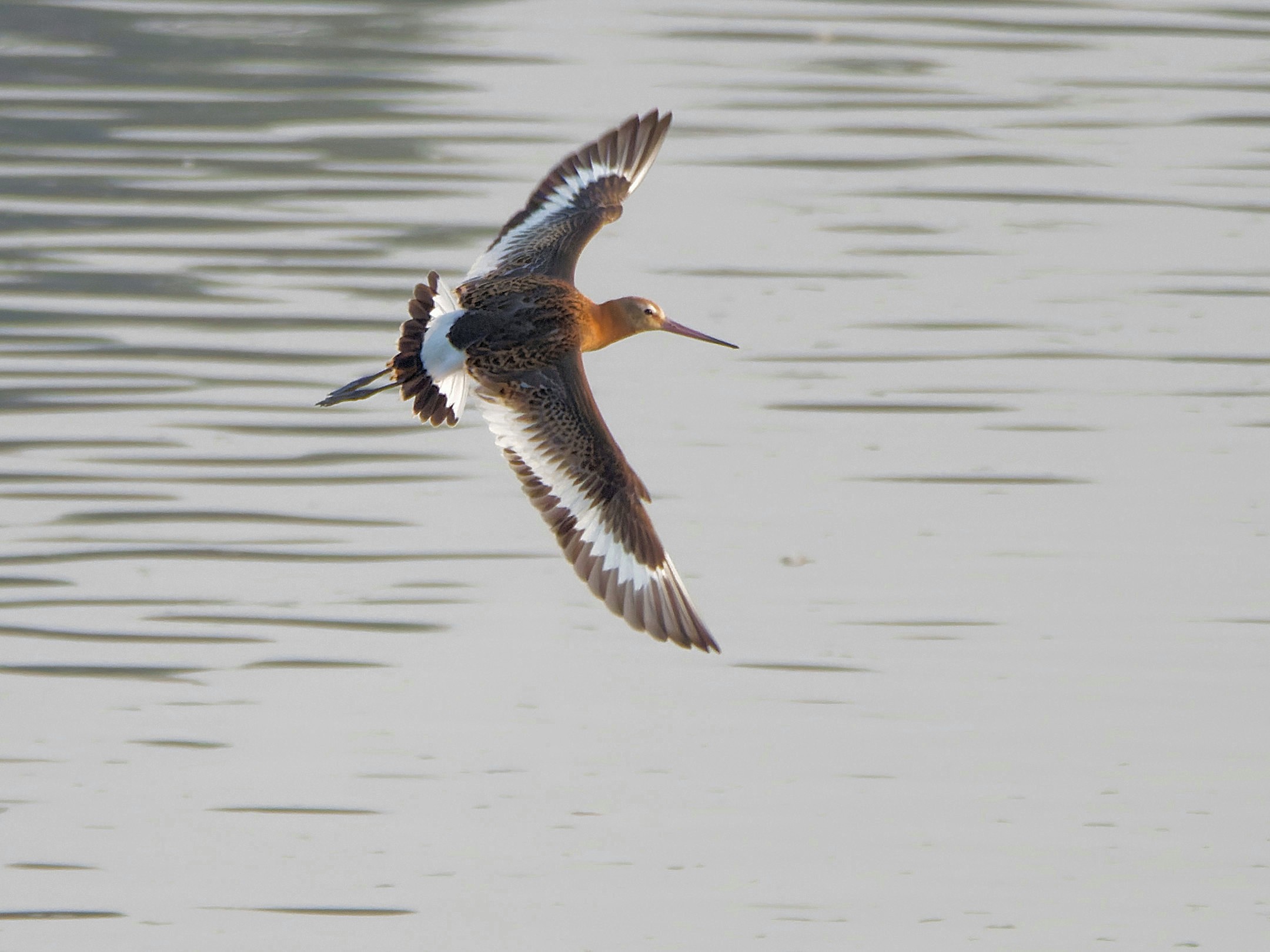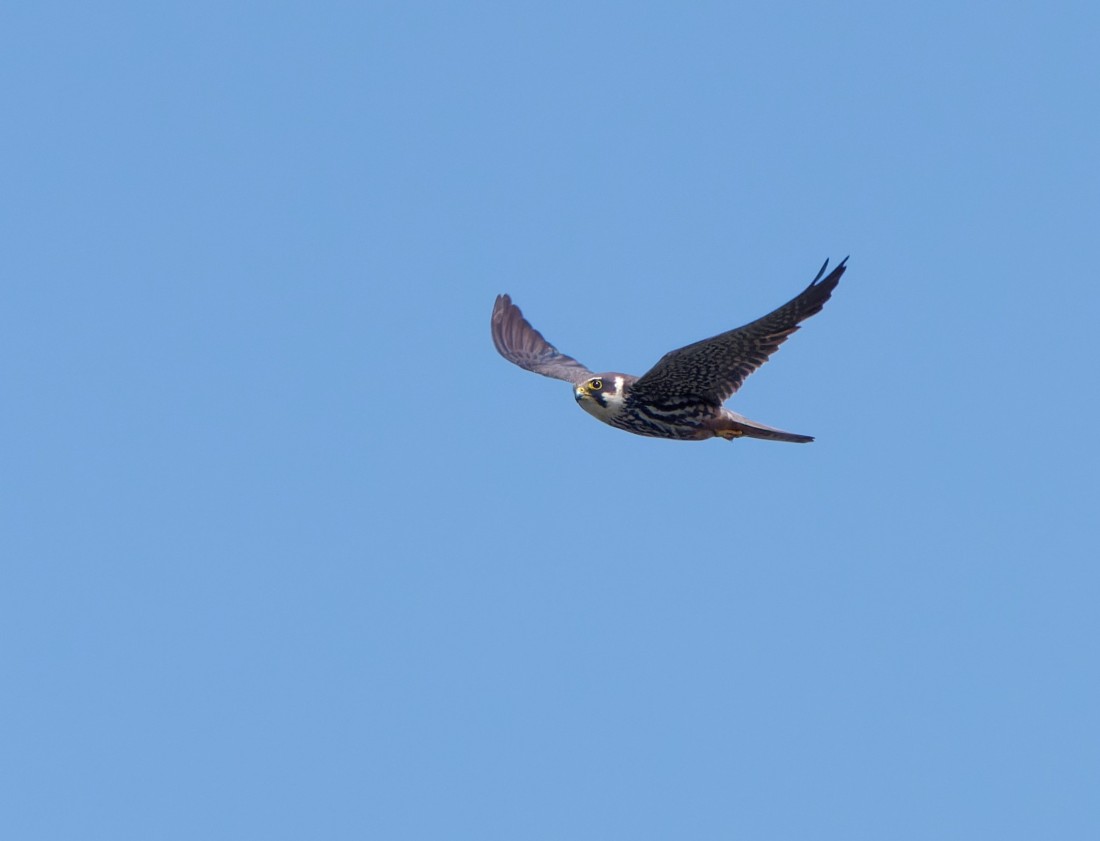Woolston Eyes Monthly Sightings
2021-09-18
A fiery dawn led on to a warm day with a light south-easterly breeze and some excellent sightings. Early on, singles of Green Sandpiper and Black-tailed Godwit were in front of the Morgan Hide, while their distinctive high-pitched whistle drew our attention to a flock of six Wigeon. Then it was down to No.1 bed and while the others were watching dragonflies, I did a circuit of the flower and seed-rich stony plain which surrounds a network of newly created pools. Counts included: 5 Yellowhammers,10 Skylarks, 47 Meadow Pipits, 100 Linnets, 55 Stock Doves and 8 Snipe. Back in the Morgan Hide, we were treated to a bit of a raptor-fest, with a family of four Hobbies (2 adults and 2 juveniles) hawking for dragonflies, which they eat on the wing, right in front of the hide. At the same time 3 Sparrowhawks (2 adults and a juvenile) were zipping around the feeding stations, trying to snatch one of the scores of feeding finches. Photo of a Hobby Cheers David (with Helen Wynn, Brian Baird, Dave Steel, Al Warford and Sue Haddock)
Submitted by: David Bowman
2021-09-11
WeBS Count Little Grebe 15, Great crested Grebe 10 , Cormorant 9, Mute Swan 23, Grey Heron 10, Grey lag Goose 86, Canada Goose 54, Wigeon 11, Gadwall 175,Teal 242 Mallard 68, Pintail 1, Shoveler 83, Pochard 2, Tufted Duck 87, Mandarin 1, Goldeneye 1,Moorhen 22, Coot 227,Water Rail 3, Kingfisher 3, Lapwing 55, Green Sandpiper 3,Curlew 1, Snipe 8, Black-headed Gull 21, Lesser Black-backed Gull 21, Great Black-backed Gull 1
Submitted by: Brian Martin
2021-09-16
This morning we started with a count from the Morgan Hide before making a late morning count around the No.4 bed wetland. Summer visitors included a hunting Hobby plus a southward trickle of hirundines, totalling 13 House Martins and 51 Swallows, plus good numbers of calling Chiffchaffs. More short distance movements from further north included 57 Meadow Pipits and 9 Grey Wagtails. Wader numbers were pretty much as expected, with 1 Black-tailed Godwit, 4 Green Sandpipers and 46 Common Snipe, though anything could turn up at this time of year. Other counts of interest included: 4 Wigeon, 4 Water Rails, 1 Kingfisher, 4 Willow Tits, 80 Shoveler, 56 Gadwall, 15 Common Buzzards, 3 Ravens, 17 Reed Buntings, 70 Teal, 150 Coot and 30 Linnets. Photo of a Migrant Hawker Cheers David (with Dan Owen)
Submitted by: David Bowman
2021-09-14
Although a cool north-easterly breeze brought drizzle early, the day eventually became clearer and warm. Waders were one of the main features, with a juvenile Black-tailed Godwit, 2 Green Sandpipers and 5 Snipe in front of the Morgan Hide at dawn. Two Water Rails, a Kingfisher and a few passing Swallows were also noteworthy, though the star birds from No.3 bed were the two juvenile Hobbies soaring together and duelling with a Sparrowhawk. Once really scarce in our area, Hobby is now a regular breeder, so it’s good to know that at least one local pair has been successful. As ever, the new No.4 bed wetland also proved good for waders, with one Green Sandpiper, 37 Snipe and a surprising four Golden Plovers, flushed with a flock of 35 Lapwings. Golden Plovers used to be a regular visitors to the arable fields adjacent to the Reserve, often in their thousands, but are now a very scarce annual visitor in small numbers. This brings the number of species of wader visiting the new wetland to an excellent17 for the year. Photo of the Black-tailed Godwit Cheers David (with Dan Owen).
Submitted by: David Bowman
2021-09-09
A quick survey of No.4 bed indicated that not much movement had taken place, with the late-staying adult Black-necked Grebe still on the Loop of the bed, plus 4 Green Sandpipers and 70 Common Snipe on the new wetland. There were then some nice views from the Morgan Hide, with 3 Kingfishers and 2 Water Rails around the scrape and a Hobby, which had earlier been flushed from a roost by the Footbridge, skimming past the front of the hide. Six Common Snipe were feeding around the bed, as the lowered water level starts to expose some nice muddy edges. It won’t be long till all our hirundines have gone to their southern wintering grounds, so it was nice to see 1 Sand Martin, 8 Swallows and 16 House Martins moving through. Other wildlife of note included an impressive European Hornet frequenting the Tower Hide and seven Migrant Hawkers. As we walked off the bed we were treated to another close view of a Hobby from the South Screen. Photo of a Black-tailed Godwit from earlier in the week Cheers David (with Daniel Owen)
Submitted by: David Bowman
2021-09-07
This mornings hot, still in autumn conditions are usually good for two things on No.3 bed - passing waders dropping in to feed and a Hobby or two arriving to hawk for the dragonflies which rise on the late morning thermals. I didn’t have to wait long for the first, as a couple of Common Snipe dropped in, followed by 21 Black-tailed Godwits, which flew west. Soon 2 more arrived, landed on the scrape, fed voraciously for an hour and then headed off to the south. These elegant waders , of the islandica subspecies, breed mainly in Iceland and around 45,000 arrive to winter in the UK, mainly at coastal sites, with smaller numbers continuing on to winter in Western France. By mid-morning large numbers of dragonflies were on the wing and, sure enough, a Hobby arrived and treated us to a couple of hours of soaring and hawking, catching plenty of dragonflies, which it ate on the wing after first biting off the wings. The presence of the Hobby also drew the attentions of migrating Swallows, with 30 pausing their journey to harass their primary predator. Photo of the Hobby Cheers David
Submitted by: David Bowman
2021-09-04
This morning it was the first visible migration sessions of the autumn from No.1 bed. A nice surprise early on was the appearance of three Roe Deer, feeding at leisure below our viewpoint. Then, Swallows started to drift and by the end of the morning 170 had moved through, while more local feeding movements included 160 Linnets and 70 Stock Doves taking advantage of the masses of seed-rich plants on the bed. Raptors were also a feature, with an Osprey passing over at great height, plus two Peregrines (an adult and a juvenile), 10 Common Buzzards, 1 Sparrowhawk and 3 Kestrels.
The link is to a short video from the past few days, showing: Water Rail, Kingfisher, Common Snipe, Green Sandpiper and Greenshank, plus some other odds and ends. To view David’s video CLICK HERE… or simply copy the following link into your browser.
https://youtu.be/jq-0rd6A5c8
Cheers David (with Dave Steel)
Submitted by: David Bowman
2021-09-02
Nice variety this morning, starting in the Morgan Hide with 2 Green Sandpipers, 2 Water Rails, a Snipe and a Kingfisher showing well. Around No.3 bed plenty of Blackcaps and Chiffchaffs were calling, with the odd Reed Warbler and Sedge Warbler still around. Then a moulting female Marsh Harrier dropped in, flushing 250 Teal from around the bed. Then it was a walk onto No.4 bed, where plenty of Green Sandpipers, Snipe, wildfowl and a few Swallows and House Martins were feeding around the wetter areas. Plenty of dragonflies, too, with counts of: 3 Emperors, 10 Ruddy Darters and 40 Common Darters, many of which were paired and ovi-positing in the smaller pools. Photo of a Kingfisher Cheers David (with Dave Steel)
Submitted by: David Bowman


